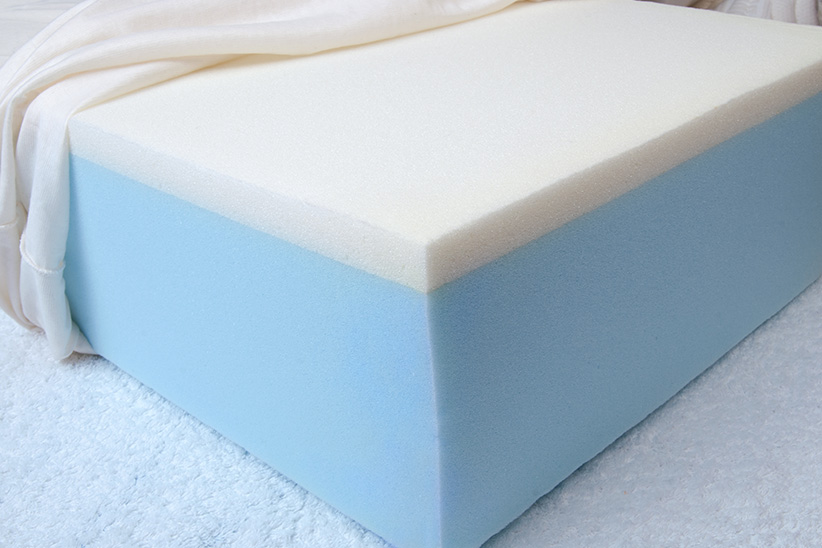What Is Memory Foam?
Updated: December 9, 2025 | Published: August 15, 2025A Brief History of Memory Foam
Memory foam was first designed in the United States by NASA in the 1960s for airplane seats. It is made from a viscoelastic material, which is both incredibly soft and highly energy absorbent.
Memory foam molds perfectly to the body in reaction to pressure and heat, evenly dispersing the weight of your frame. The original shape of the foam then returns once you remove the pressure. In addition to safeguarding against impact, these properties make memory foam exceptionally comfortable.
After it was established as a mainstay for NASA, memory foam made a sortie into other applications, such as the cushioning in shoes and helmets. Uses were also found in the field of medicine; more specifically, in products to prevent pressure ulcers and prosthetics.
That’s when the magic material began to take off. Memory foam was adopted in the manufacture of mattresses, mattress pads, and pillows, which are now available commercially in a vast range of different densities and brand names.
The Science Behind the Foam

In contrast to the bouncy polyurethane foams of old mattresses, memory foams have very little spring. Rather than bouncing, they retain and mold to the shape of a sleeper’s body — hence the name “memory” — and gradually return to their original structure. Supporters of memory foam say the effect can relieve tension and prevent pressure sores.
The very first memory foam mattresses had a comparatively closed cell structure that did not allow air to flow freely, creating what is recognized in the industry as an unfavourable microclimate around the body. Translation: customers who bought the mattresses often murmured afterwards that they got overheated while they slept.
The solution to this troubling problem was to improve the airflow by opening up the cell structure. Improvements began around 2010 when researchers started to play around with functionality, reactivity, molecular weight, and backbone to create a more open type of foam structure. Since then, the moisture-wicking capability of the new foam has also been vastly improved.
As polyurethane raw material suppliers such as Dow assist in refining airflow, foam formulators are making efforts to dispel the sleep hot reputation of memory foam and improve the experience of mattress customers.
What is Viscoelasticity?
The concept of memory foam is quite simple. Rather than sleeping on springs, you lay on a very dense foam that gives way wherever you press on it. Technically speaking, the term is viscoelastic. Visco — originating from the word “viscous” — means that it moves, somewhat slowly, when you apply a force. “Elastic” means that it returns to its original shape once the force is removed.
The foam itself is temperature sensitive, so it sinks more as your body temperature heats it up, and then rapidly molds to the unique contours of your body. If you happen to sleep on your side, the foam sinks a fair amount more at your hips and shoulders, so that in theory, your entire body is always evenly supported and your spine is always straight.
Additionally, your weight is spread far more equally, which means that the pressure is relieved on your bones. That’s why countless people find that memory foam mattresses are a huge help in reducing the symptoms of problems such as arthritis and back pain. If you change your sleeping position or turn over in the night the mattress molds to your new shape.
The Final Verdict
It is abundantly clear that the use of a memory foam mattress can provide individuals with numerous health benefits. One advantage of memory foam mattresses that hasn’t been mentioned yet is the drastic and immediate relief that it can provide from common allergies.
Memory foam is made of polyurethane, which is an inorganic fibre. These fibres thwart allergy-causing dust mites and stop them from settling in since there is no food for them to thrive on within a memory foam mattress. Organic fibres such as cotton attract dust mites that may also feed off of dead skin.
These hypoallergenic benefits are of course in addition to the above-mentioned advantages of memory foam, including pain relief. If you don’t own one yet, a memory foam mattress is one of the best ways to reap significant health benefits.
Shopping for a new memory foam mattress? Consider Octave, a Canadian-made memory foam mattress. Its comfort layer is infused with copper for rapid heat dissipation and treated with a temperature-balancing phase-change material to correct the temperature sensitivity of foam. Moreover, Octave’s base layer features high-density foam, multi-zone support, and horizontal air channels for pressure-point relief.
